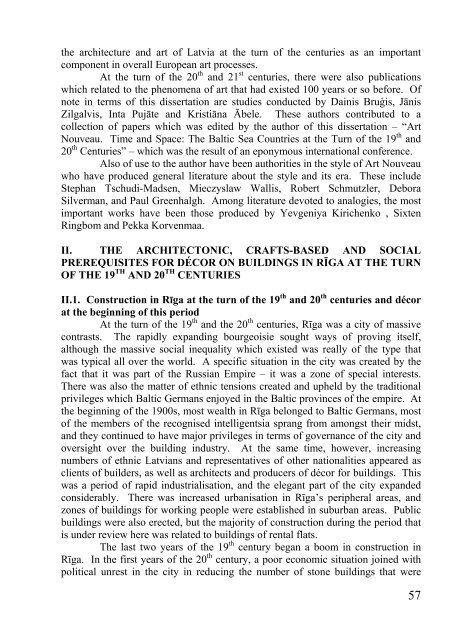SILVIJA GROSA JŪGENDSTILA PERIODA PLASTISKAIS UN ...
SILVIJA GROSA JŪGENDSTILA PERIODA PLASTISKAIS UN ...
SILVIJA GROSA JŪGENDSTILA PERIODA PLASTISKAIS UN ...
You also want an ePaper? Increase the reach of your titles
YUMPU automatically turns print PDFs into web optimized ePapers that Google loves.
the architecture and art of Latvia at the turn of the centuries as an important<br />
component in overall European art processes.<br />
At the turn of the 20 th and 21 st centuries, there were also publications<br />
which related to the phenomena of art that had existed 100 years or so before. Of<br />
note in terms of this dissertation are studies conducted by Dainis Bruģis, Jānis<br />
Zilgalvis, Inta Pujāte and Kristiāna Ābele. These authors contributed to a<br />
collection of papers which was edited by the author of this dissertation – “Art<br />
Nouveau. Time and Space: The Baltic Sea Countries at the Turn of the 19 th and<br />
20 th Centuries” – which was the result of an eponymous international conference.<br />
Also of use to the author have been authorities in the style of Art Nouveau<br />
who have produced general literature about the style and its era. These include<br />
Stephan Tschudi-Madsen, Mieczyslaw Wallis, Robert Schmutzler, Debora<br />
Silverman, and Paul Greenhalgh. Among literature devoted to analogies, the most<br />
important works have been those produced by Yevgeniya Kirichenko , Sixten<br />
Ringbom and Pekka Korvenmaa.<br />
II. THE ARCHITECTONIC, CRAFTS-BASED AND SOCIAL<br />
PREREQUISITES FOR DÉCOR ON BUILDINGS IN RĪGA AT THE TURN<br />
OF THE 19 TH AND 20 TH CENTURIES<br />
II.1. Construction in Rīga at the turn of the 19 th and 20 th centuries and décor<br />
at the beginning of this period<br />
At the turn of the 19 th and the 20 th centuries, Rīga was a city of massive<br />
contrasts. The rapidly expanding bourgeoisie sought ways of proving itself,<br />
although the massive social inequality which existed was really of the type that<br />
was typical all over the world. A specific situation in the city was created by the<br />
fact that it was part of the Russian Empire – it was a zone of special interests.<br />
There was also the matter of ethnic tensions created and upheld by the traditional<br />
privileges which Baltic Germans enjoyed in the Baltic provinces of the empire. At<br />
the beginning of the 1900s, most wealth in Rīga belonged to Baltic Germans, most<br />
of the members of the recognised intelligentsia sprang from amongst their midst,<br />
and they continued to have major privileges in terms of governance of the city and<br />
oversight over the building industry. At the same time, however, increasing<br />
numbers of ethnic Latvians and representatives of other nationalities appeared as<br />
clients of builders, as well as architects and producers of décor for buildings. This<br />
was a period of rapid industrialisation, and the elegant part of the city expanded<br />
considerably. There was increased urbanisation in Rīga’s peripheral areas, and<br />
zones of buildings for working people were established in suburban areas. Public<br />
buildings were also erected, but the majority of construction during the period that<br />
is under review here was related to buildings of rental flats.<br />
The last two years of the 19 th century began a boom in construction in<br />
Rīga. In the first years of the 20 th century, a poor economic situation joined with<br />
political unrest in the city in reducing the number of stone buildings that were<br />
57












